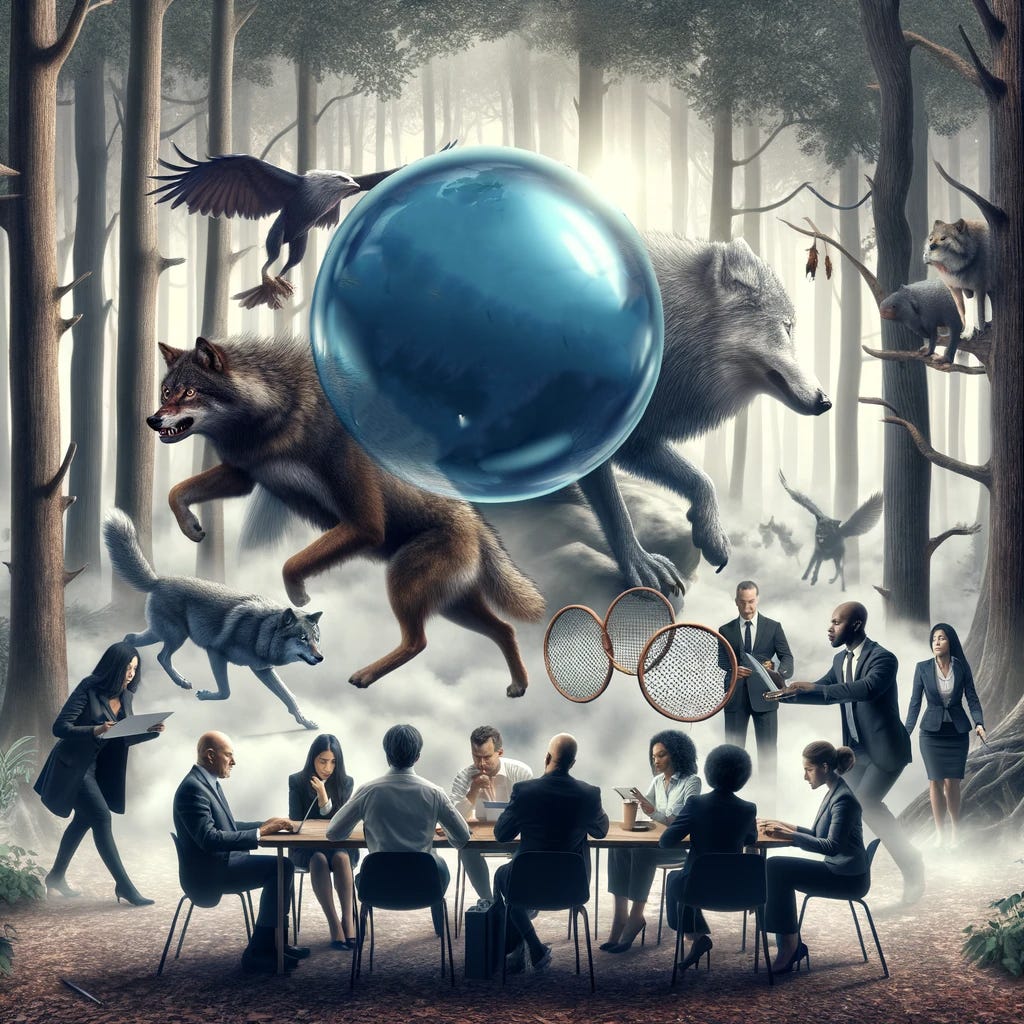
Sales, especially in high-value B2B, is competitive. The more complex and valuable the product or service, the more people you need to manage during the sales process. Selling something simple like test automation is straightforward – you just need the right technology, experience, and price. But for bigger projects, like a digital transformation for an insurance company’s customer experience, it’s more than just the basics. You need to consider reputation, credibility, the ability to deliver, expertise, internal politics of the buyer, and more. Here, sales shift from a solo effort to a team activity.
Core Idea: Working together like our ancestors who foraged in groups is key to winning big deals. In a team, everyone depends on each other, and going solo is risky. Each person must contribute and support others, but they can also expect help if they face difficulties.
I use the term ‘hunt in packs’ to highlight the difference in selling approaches, between the lone wolf type seller and selling as a pack. In the book, “The Elephant in the Brain: Hidden Motives in Everyday Life” by Kevin Simler and Robin Hanson the authors discuss Foraging and how it played a critical role in humanity’s continued survival and evolution.
I’ve been in sales for nearly 30 years, mostly leading teams on big deals worth millions. Applying the techniques of hunting in packs (foraging) have helped earn over $650 million for my companies. Here are seven important sales lessons from the world of foraging that we can use in B2B deals.
-
Resource Availability: For foraging to work, there need to be things worth looking for. In sales, this is like making sure a large deal is worth your time. It includes simple things like how much the deal is worth and if you can actually get involved in it. It also covers more complex things like getting useful information and building relationships.
-
Search and Decision-Making Strategy: Good foraging means having a plan for what to look for and how to choose what’s best to go after. This means figuring out how valuable different things could be, thinking about the pros and cons of chasing them, and then deciding what to do. In sales, this is like deciding when to involve your CEO in a deal or how much money to spend on marketing for specific accounts.
-
Adaptability and Learning: Successful foragers are adaptable and capable of learning from their environment. They can change their strategies based on the availability of resources, competition, and other environmental factors. This learning process is continuous and involves both short-term adjustments and long-term evolutionary adaptations. In my previous company, the need to win a deal led us to acquire new capability that was previously not part of the corporate strategy.
-
Risk Management: Foraging involves managing risks, such as the risk of expending more energy in the search than is gained from the resource, or the risk of exposure to predators (or, in human contexts, to competitors or other threats). Effective foragers balance the potential rewards with these risks. An example would be to consider the benefit of opting out of a deal that will cost more what you can afford to spend on pursuit at this stage as a company.
-
Efficiency: Foraging strategies aim to maximize efficiency — obtaining the highest possible return for the lowest possible investment of energy and resources. This involves optimizing travel paths, timing, and methods of extraction or acquisition. An example would be leveraging partnerships to reduce costs while improving competitiveness in large deals.
-
Opportunism: Successful foragers often exhibit opportunistic behavior, taking advantage of unexpected resources or conditions that may arise. This flexibility can be crucial for survival and success. For example, they might offer extra services that go well with the main deal, even if the customer hadn’t thought of it. This quick thinking and flexibility can really help in getting ahead.
-
Social Dynamics: In sales, just like in human foraging, working with others and managing relationships are key. You need to cooperate, share information, and sometimes compete. This is crucial in big deals where you might meet over 15 different buyers, each with their own goals, power, and needs, multiple times over several months. At a bare minimum, you have to handle 1000s of interactions across multiple channels without upsetting anyone or missing important signals.
-
Ecological Interaction: Foraging is not isolated; it’s influenced by the surrounding environment, like other creatures, changes in surroundings, and resource availability. In sales, this means considering things like regulations, tech trends, the overall economy, and politics. For example, if you’re selling tech solutions, you need to stay aware of new laws affecting technology, current market conditions, and political shifts that could impact your client’s willingness or ability to invest in new tech.
In Conclusion: The Art of Sales Foraging
Every high-performance sales professional engages in a form of ‘foraging’ for clients and opportunities. These lessons from the foraging world provide a blueprint for developing strategies that cater to identifying and seizing valuable opportunities, adapting to market changes, and efficiently allocating resources.
I look forward to your thoughts and comments on these insights. Let’s discuss how we can apply these ancient strategies to modern sales challenges!
